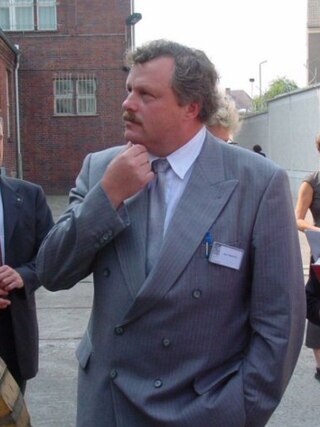
The Ministry for State Security, commonly known as the Stasi, was the state security service and secret police of East Germany from 1950 to 1990. It was one of the most repressive police organisations in the world, infiltrating almost every aspect of life in East Germany, using torture, intimidation and a vast network of informants to crush dissent.

Erich Fritz Emil Mielke was a German communist official who served as head of the East German Ministry for State Security, better known as the Stasi, from 1957 until shortly after the fall of the Berlin Wall in 1989. Dubbed "The Master of Fear" by the West German press, Mielke was one of the most powerful and most hated men in East Germany.

Gesine Lötzsch is a German politician of the left-wing party Die Linke. In 2010, with Klaus Ernst, she was elected president of the party.

Lichtenberg is the eleventh borough of Berlin, Germany. In Berlin's 2001 administrative reform it absorbed the former borough of Hohenschönhausen.

Wilhelm Zaisser was a German communist politician and statesman who served as the founder and first Minister for State Security of the German Democratic Republic (1950–1953).

SV Lichtenberg 47 is a German association football club from Berlin. The footballers are part of a larger sports club that currently has over 900 members in departments for bowling, boxing, fitness and aerobics, gymnastics, line dancing, table tennis, and volleyball.

The Sportvereinigung Dynamo was the sport association of the security agencies of former East Germany.
The Stasi Records Agency was the organisation that administered the archives of Ministry of State Security (Stasi) of the former German Democratic Republic. It was a government agency of the Federal Republic of Germany. It was established when the Stasi Records Act came into force on 29 December 1991. Formally it was called the Federal Commissioner for the Records of the State Security Service of the former German Democratic Republic ; the official German abbreviation was BStU. On June 17, 2021, the BStU was absorbed into the German Federal Archives (Bundesarchiv).

Hubertus Knabe is a German historian and was the scientific director of the Berlin-Hohenschönhausen Memorial, a museum and memorial in a notorious former Stasi torture prison in Berlin. Knabe is noted for several works on oppression in the former Communist states of Eastern Europe, particularly in East Germany. He became involved with green politics, and was active in the Alliance '90/The Greens.

The Medal for Exemplary Border Service was a national award issued in the German Democratic Republic (GDR). It was established on 28 May 1954, by the Council of Ministers of the GDR with Order No. 47/54 from the Ministry of Interior on 16 June 1954. The first presentation ceremony took place on 1 July 1954, to members of the German Border Police.

Siegfried Reiprich is a German human rights activist and author. He was involved in the resistance against the communist regime of the German Democratic Republic (GDR), which led to him being expelled from university and eventually banished from the GDR. In 2009, he was appointed by the Government of Saxony as the Director of the Stiftung Sächsische Gedenkstätten. In 2011, he was elected as a member of the Executive Board of the Platform of European Memory and Conscience.

Zersetzung was a psychological warfare technique used by the Ministry for State Security (Stasi) to repress political opponents in East Germany during the 1970s and 1980s. Zersetzung served to combat alleged and actual dissidents through covert means, using secret methods of abusive control and psychological manipulation to prevent anti-government activities. People were commonly targeted on a pre-emptive and preventive basis, to limit or stop activities of dissent that they may have gone on to perform, and not on the basis of crimes they had actually committed. Zersetzung methods were designed to break down, undermine, and paralyze people behind "a facade of social normality" in a form of "silent repression".

Helmut Müller-Enbergs is a German political scientist who has written extensively on the Stasi and related aspects of the German Democratic Republic's history.
An unofficial collaborator or IM, or euphemistically informal collaborator, was an informant in the German Democratic Republic who delivered private information to the Ministry for State Security. At the end of the East German government, there was a network of around 189,000 informants, working at every level of society.
Jens Gieseke is a German historian. His work is focused on the German Democratic Republic and its Ministry for State Security.
Karli Coburger is a former Major general in the East German Ministry for State Security . In 1984 he became, as matters turned out, the last head of the service's Central Department for surveillance, fact finding and arrests.
Erich Bär was a resister against Nazism and later lieutenant colonel of Ministry of State Security (Stasi) of the GDR. He was, from 1957 to 1972, head of the executive offices of the Stasi in East Berlin.

The Memorial and Education Centre Andreasstraße, is a museum in Erfurt, Germany, which is housed in a former prison used by the East German Ministry for State Security (Stasi). It is informally known as the Stasi Museum.
Hanns Leske is a German sports historian, political scientist and former Berlin local politician.

Klaus Sorgenicht was a German politician and party functionary of the Socialist Unity Party (SED).



























